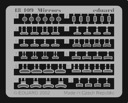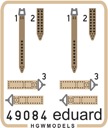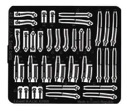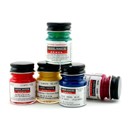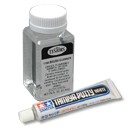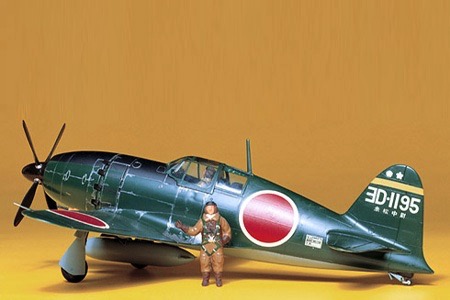

Raiden Interceptor (Jack/Jake)
Unassembled plastic model kit
Other products to consider
Customize your model:
Don't forget building supplies!


In Stock (Ships in 1-3 business days)List price: $17.50
You pay less than: $17.50
Add to cart to see actual sales price.

Manufacturer: Tamiya Models and Paints
Stock Number: TAM 61018
Scale: 1/48
View all products of type "J2M Raiden"
You pay less than: $17.50
Add to cart to see actual sales price.


Manufacturer: Tamiya Models and Paints
Stock Number: TAM 61018
Scale: 1/48
View all products of type "J2M Raiden"
This model kit requires assembly. Cement, paint and other construction materials not included unless specifically stated in the description.
About the Raiden (JACK)
In September 1939, aircraft manufacturers Nakajima and Mitsubishi received an unofficial order to trial-manufacture the Raiden, the Japanese Navy's first interceptor (a fighter to undertake the air defence of land bases). It was finally decided, however, that the development and trial-manufacture of the Raiden should be conducted only by Mitsubishi. It was in April of 1940 that the plane was designated "14-Shi Interceptor (J2M1)" and official requirements were set out by the Navy. The requirements gave priority to climbing power, maximum speed and high altitude performance. Aircraft engines of those days that could meet all these requirements were only the air-cooled engine "Kasei" type 11 trial-manufactured by Mitsubishi for the Type 1 Attack Bomber (G4M) "Betty" and the liquid-cooled engine "Atsuta" trial-manufactured by Aichi. Because of the Navy's poor experience in liquid-cooled engines and Atsuta's insufficient reliability, the Navy was forced to employ the air-cooled engine Kasei which, having larger engine diameter and giving larger air resistance, was not best suited to be used in a fighter. The Raiden was designed by engineer Jiro Horikoshi and his designers who had taken charge of the Zero Fighter. To lessen air resistance, was not best suited to be used in a fighter. The Raiden was designed by engineer Jiro Horikoshi and his designers who had taken charge of the Zero Fighter. To lessen air resistance, the propeller shaft of the engine was made longer and the cowling was made slenderer. To obtain higher cooling efficiency, the forced-cooling fan was used. The body was spindle-shaped with its largest section at the 40% of its overall length. The wing load was as large as 145 kg/m^2 and, in due consideration of dogfights, Fowler flaps were employed. The retracting system and propeller pitch changing system of the electric type were employed in place of those of the hydraulic type which had a bad reputation.
The 14-Shi Interceptor made its first flight at Kasumigaura Airfield on 20th March, 1942. As a result of various tests flights made thereafter, defects such as insufficient power of the Kasei engine, bad vibration of the extended propeller shaft and poor visibility were pointed out. A production type which bettered visibility by shortening the nose and remodelling the canopy and mounted the more powerful Kasei 23 engine equipped with the water-methanol injection system made its first flight on 13th October, 1942. The production type also developed many troubles in the engine and other sections, and it was in December 1943 that the plane was accepted for use under the name of Raiden Type 11 (J2M2). In the meantime, the Raiden Type 21 (J2M3), an anti-bomber fighter which had more powerful armament consisting of four belt-fed 20mm machine guns, was completed in October 1943 and now became the main object of production. The production of the Type 21 totaled about 300.
The Raiden Type 21 first saw action in the Battle of Mariana in September 1944. Subsequently, some were sent to the Philippines and Formosa and took part in actions, but the result was not as good as the Japanese had expected. It was in air defense actions for the mainland by the Raiden unit of the 302nd Air Group based on Atsugi that the Raiden exercised its own power to the full and showed the most brilliant activity. The Raiden unit distinguished itself by shooting down a total of about 300 enemy planes in the short period from the end of 1944 to the end of the war. It owed much of its success to the fact that it could readily obtain necessary material from the nearby Koza naval air arsenal which produced the Raiden, the geographical conditions that its base Atsugi was located near the course of B29 bombers intruding into the Kanto district, and the best consolidated air defense system and air defense control by means of radar network.
In September 1939, aircraft manufacturers Nakajima and Mitsubishi received an unofficial order to trial-manufacture the Raiden, the Japanese Navy's first interceptor (a fighter to undertake the air defence of land bases). It was finally decided, however, that the development and trial-manufacture of the Raiden should be conducted only by Mitsubishi. It was in April of 1940 that the plane was designated "14-Shi Interceptor (J2M1)" and official requirements were set out by the Navy. The requirements gave priority to climbing power, maximum speed and high altitude performance. Aircraft engines of those days that could meet all these requirements were only the air-cooled engine "Kasei" type 11 trial-manufactured by Mitsubishi for the Type 1 Attack Bomber (G4M) "Betty" and the liquid-cooled engine "Atsuta" trial-manufactured by Aichi. Because of the Navy's poor experience in liquid-cooled engines and Atsuta's insufficient reliability, the Navy was forced to employ the air-cooled engine Kasei which, having larger engine diameter and giving larger air resistance, was not best suited to be used in a fighter. The Raiden was designed by engineer Jiro Horikoshi and his designers who had taken charge of the Zero Fighter. To lessen air resistance, was not best suited to be used in a fighter. The Raiden was designed by engineer Jiro Horikoshi and his designers who had taken charge of the Zero Fighter. To lessen air resistance, the propeller shaft of the engine was made longer and the cowling was made slenderer. To obtain higher cooling efficiency, the forced-cooling fan was used. The body was spindle-shaped with its largest section at the 40% of its overall length. The wing load was as large as 145 kg/m^2 and, in due consideration of dogfights, Fowler flaps were employed. The retracting system and propeller pitch changing system of the electric type were employed in place of those of the hydraulic type which had a bad reputation.
The 14-Shi Interceptor made its first flight at Kasumigaura Airfield on 20th March, 1942. As a result of various tests flights made thereafter, defects such as insufficient power of the Kasei engine, bad vibration of the extended propeller shaft and poor visibility were pointed out. A production type which bettered visibility by shortening the nose and remodelling the canopy and mounted the more powerful Kasei 23 engine equipped with the water-methanol injection system made its first flight on 13th October, 1942. The production type also developed many troubles in the engine and other sections, and it was in December 1943 that the plane was accepted for use under the name of Raiden Type 11 (J2M2). In the meantime, the Raiden Type 21 (J2M3), an anti-bomber fighter which had more powerful armament consisting of four belt-fed 20mm machine guns, was completed in October 1943 and now became the main object of production. The production of the Type 21 totaled about 300.
The Raiden Type 21 first saw action in the Battle of Mariana in September 1944. Subsequently, some were sent to the Philippines and Formosa and took part in actions, but the result was not as good as the Japanese had expected. It was in air defense actions for the mainland by the Raiden unit of the 302nd Air Group based on Atsugi that the Raiden exercised its own power to the full and showed the most brilliant activity. The Raiden unit distinguished itself by shooting down a total of about 300 enemy planes in the short period from the end of 1944 to the end of the war. It owed much of its success to the fact that it could readily obtain necessary material from the nearby Koza naval air arsenal which produced the Raiden, the geographical conditions that its base Atsugi was located near the course of B29 bombers intruding into the Kanto district, and the best consolidated air defense system and air defense control by means of radar network.

Copyright © 2005-2024 Scale Hobbyist, all rights reserved













